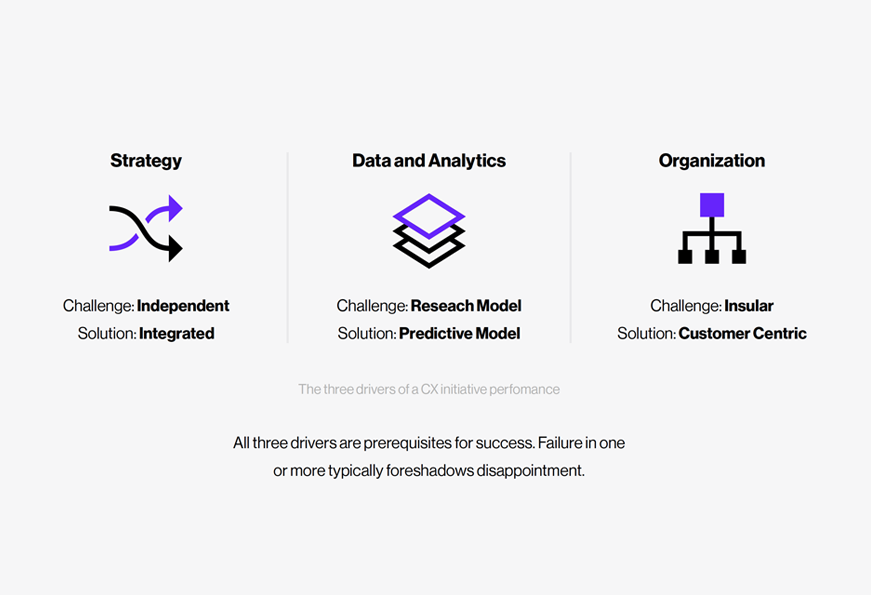The Three Root Causes
of NPS Failure
What more than 1,000 implementations reveal about most CX program failures.
In The New NPS Manifesto, we explored the ten problems behind the distressing fact most corporate CX initiatives produce nothing but metrics and scorecards. No actions. No meaningful financial results. Our extensive experience over the past fifteen years or so has given us a detailed understanding of the reasons.
We know that corporate CX failure can be traced to three root causes. And we believe all three can addressed.
Well done is better than well said.
– BENJAMIN FRANKLIN

Source: OCX Cognition, The New NPS Manifesto.
Strategy
First, let’s consider the typical CX strategy. We used to believe that ‘best practice’ was for CX leaders from each business and function to come together and define the corporate customer experience strategy. We have facilitated such workshops. They tend to be intense, and highly satisfying to the participants. Each business and function leader presents what they are doing and this is aggregated in some way to provide an overall picture. In optimal situations, the resulting strategy statement and action plan are presented to the executive committee and approved. Great stuff, right?
Contrary to what we believed in earlier times, we now know strategies developed that way should be put in the trash right away.
The only acceptable way to create an enduring customer experience strategy is to start with the overall corporate strategy. The purpose of a CX strategy is to make the corporate strategy more successful.
Before you say your strategy is fully aligned with corporate strategy, here is a question. When people in your company talk about successful customer experience work, do they mainly talk about resolving complaints and dealing with escalations – in short, putting out fires? Or are the discussions about improving sales win rates, increasing contract renewal rates and providing differential experiences as you enter new markets? If your work is mainly firefighting, you have a major strategic alignment problem. If you think you don’t, we suggest you read your corporate strategy statement again, to find out how often it mentions customer complaints in the context of the overall business strategy.
Data & Analytics
Our ten problem statements point quite clearly to the second root cause of CX failure: traditional CX research data is woefully insufficient. It is not available on a real time basis and it is not integrated with the way the rest of your company manages its business.
Think of a situation where you have travelled to a country where the local population does not speak the same language as you speak at home. Whose problem is that, theirs or yours? The answer is clear: It’s yours!
You may “speak survey,” but on its own, traditional survey data as the source of all insights and improvements is a foreign language to the rest of your company. That’s your problem, not theirs. CX professionals must speak the same language as the rest of the corporation. From a data perspective this means using the same operational data as everyone else, with the aim of improving the same financial results that are the goal of the rest of the corporation.
We haven’t always had a Rosetta Stone for moving between survey-driven insights, including NPS, and operational data. But recent advances in AI and analytics mean it is now possible to determine which operational data streams are most relevant to customers, and to create a new approach to NPS that honors that relevance. We can integrate the operational and CX data to understand which customers are likely to buy more and which are most likely to leave, creating a fundamentally improved approach: Spectrum NPS.
Linkage to financial data also matters. A crucial gap in current accounting standards is that there is no agreement on how much a customer is worth. Without an agreed methodology for determining the value of a customer and of your entire customer base it is impossible to gain agreement on the ROI of any investment the intent of which is to improve that value. Improving customer retention and upsell rates obviously improves customer lifetime value. How much is that worth? Nobody agrees. We have risen to that challenge and propose a customer lifetime value standard that is the subject of a separate article.
Organizational Model
To explore the third root cause of CX failure, let’s take an instructive example.
After her years as CEO of eBay and a failed attempt to become the governor of California, Meg Whitman took over as CEO of HP. A former Bain employee, Meg was familiar with NPS. HP’s recent years had seen massive top-line growth driven by mergers and acquisitions.
As Meg reviewed the various business and functions, she was surprised to discover that each had its own customer experience metrics and that almost all were metrics that did not exist in other companies. Understanding the metrics was challenging. Communicating them across silos was close to impossible. She wanted to impose brand-level NPS as the main metric and looked for the corporate CX leader to implement this. Surprise! There was no central leader or team. So she put one in place, with representatives from each business and major function. The first task was implementing NPS and training everyone on what it was and how to use it to drive improvements.
A central CX team is critical to corporate strategic alignment. Customers also have improvement suggestions that cross organizational boundaries. Without a central team, they cannot possibly get addressed.
ABOUT OCX COGNITION
OCX Cognition delivers the future of NPS. We ensure customer experience success by combining technology and data science with programmatic consulting. In our Insights section, we present a comprehensive and evolving collection of resources based on our research and expertise, collected for CX leaders committed to delivering business outcomes.
Featured Insights

The New NPS Manifesto: What Is the New NPS Manifesto?
Two years of research built on 15 years of CX leadership.

Leading a CX Program in Extreme Circumstances
Learn to manage your program today while preparing for the post-pandemic “new normal.”

You Want to Justify a CX investment? Forget the Scorecards
Your CEO and leadership team don’t decide based on numbers.
